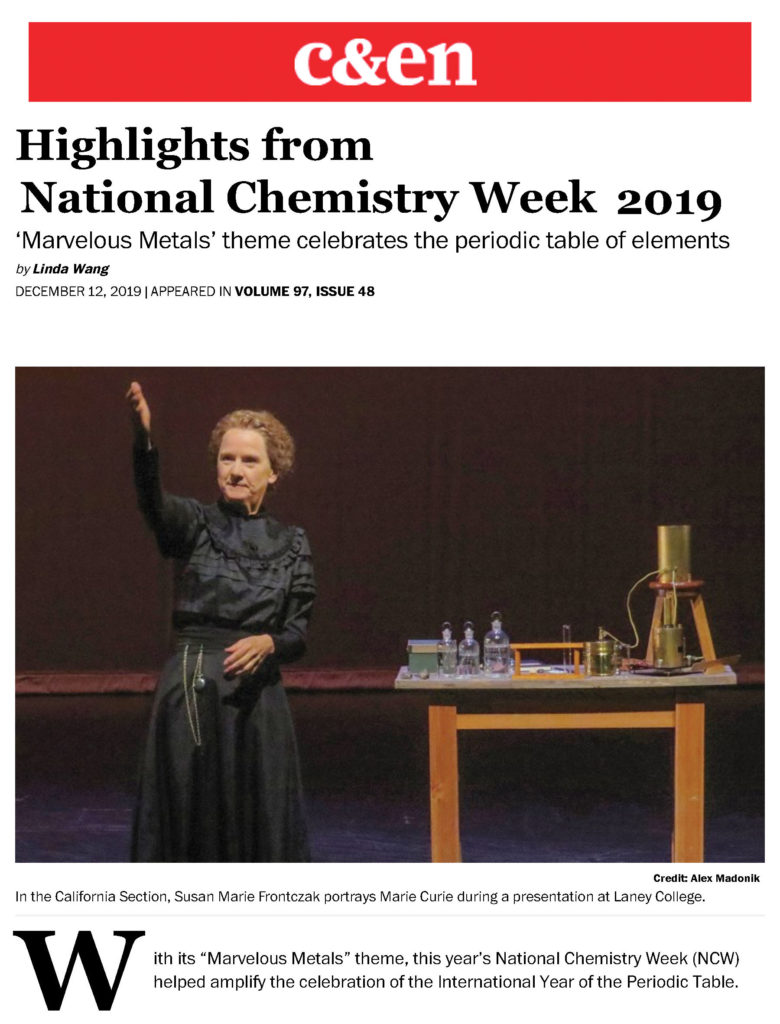Manya – The Living History of Marie Curie

On Saturday, October 19, 2019, about 90 people gathered to watch Susan Marie Frontczak present her single-person performance on the life of Maria “Manya” Sklodowska Curie. The event was part of a celebration of the International Year of the Periodic Table and was hosted by the California Section, Women Chemists’ Committee, the American Chemical Society, and the American Association of University Women. Laney College’s Performing Arts Theater met all the requirements of Susan Marie Frontczak and was accessible by public transportation.
The show begins with a travel back in time to April 1915, as the actress impersonates Manya recalling her life up to that time, including numerous personal and professional challenges:
- Her early life in Poland, including poverty and political repression;
- Her coming to France for education, and forming a professional partnership with fellow scientist Pierre Curie that bloomed into a romantic partnership;
- The Curies’ constant struggles for income and laboratory space while rearing two daughters;
- The herculean task of extracting one tenth of a gram of radium from over a ton of pitchblende, using a converted shed as a laboratory;
- The Curies’ dismay at the disruptions in their lives after winning the Nobel Prize; and
- The irony of receiving the Curies’ longed-for laboratory space only after Pierre’s tragic death in a road accident.
The show ends with Manya coming out of her shell, overcoming her natural shyness to set up X-ray units at field hospitals so that soldiers wounded in World War I could be promptly diagnosed and treated.
Throughout, the actress uses simple props and gestures to make her point. For example, the table on the right of the stage represents Marie’s laboratory and the table on the left represents her life outside the lab. She uses shoveling motions while describing the difficulties of extracting radium from pitchblende. Most important, she explains the science in layman’s terms, first explaining how she used tiny differences in the solubility of barium and radium salts to separate them, and introducing the formal scientific term “fractional crystallization” at the end.
Overall, this was an entertaining performance that honors Curie’s memory and makes her science accessible to the general public.
A shorter version of the Manya performance is available for use in schools. The California Section of ACS collaborated with the Korematsu Middle School in El Cerrito, CA to provide this shorter program for its students free of charge. This West Contra Costa Unified School District school was chosen because of the very diverse nature of the 7th and 8th grade student body, and because it is the only school in El Cerrito named after an individual of Asian background — Presidential Medal of Freedom winner Fred T. Korematsu. Since much of Marie Curie’s life history involves attempts to achieve freedom in accessing education, in speaking her native language (Polish), and in obtaining proper research facilities, this site was most suitable to mesh the natural school themes with the lessons of the show’s main character. Over 700 students viewed the program in morning and afternoon assemblies, held in their multipurpose room on October 17.
The importance of exposing young students to Curie’s story was emphasized by a startling interaction before the performance at Laney: Elaine Yamaguchi talked to a male in his late thirties who had never heard of Marie Curie. He was curious about the event posters and what was going on at the theater, though he eventually decided on a walk around the lake. Although it was clear he was not a scientist, it seems strange indeed that anyone living on the same planet as the rest of us could not have heard of Marie Curie! No matter what these Korematsu middle schoolers become as adults, they will have learned the facts of Marie Curie’s life and the obstacles she faced and overcame.
Nicki Davis, PhD
Nicki Davis is a longtime member of the American Chemical Society (ACS) with experience in NMR spectroscopy and cheminformatics. She is also an Associate Fellow of the Society for Technical Communication (STC).
